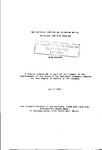THE RATIONALISATION OF DRINKING WATER SUPPLIES FOR PIG HOUSING
| dc.contributor.author | BARBER, JOHN | |
| dc.contributor.other | Faculty of Science and Engineering | en_US |
| dc.date.accessioned | 2013-10-30T10:09:01Z | |
| dc.date.available | 2013-10-30T10:09:01Z | |
| dc.date.issued | 1992 | |
| dc.identifier | NOT AVAILABLE | en_US |
| dc.identifier.uri | http://hdl.handle.net/10026.1/2463 | |
| dc.description.abstract |
This study consisted of a series of experiments which investigated the water use of growing/finishing pigs (25-90 kg), newly weaned pigs (5- 12 kg) and gestating sows. Drinker type was found to affect water use in growing pigs. For example significantly more water (28 %) was used from Mono-flo nipple drinkers than Arato bite drinkers (P<0.01). For all classes of pigs studied water use was significantly increased by increasing the water delivery rate. The percent increase in water use over the extremes of water delivery rate tested in individual trials were respectively: ration fed growing pigs, 105 % (300-900 cm³ /min P<0.001); ad libitum fed growing pigs, 52% (200-1100 cm³/min P<0.01); gestating sows, 25% (500-2500 cm³/min P<0:01); and newly weaned pigs 109% (175-700 cm³ /min P<0.001). In newly weaned piglets, increasing the water delivery rate from 175 to 700 cm³/min resulted in a significant increase in feed intake (44 g/piglet/day, P<0.001) and growth rate (37 g/piglet/day, P<0.01). For growing pigs (27-55 kg), a relationship was established between water intake, feed intake and liveweight, from which it could be hypothesised that the pig had a limit to daily volumetric intake. This was found to be 12.0 ±1.2 % of liveweight. When feed intake was restricted, water intake increased to maintain the 12% volumetric limit. This hypothesis was validated from other published work extending the weight range to 105 kg. Evidence was produced indicating that newly weaned pigs also have a constant volumetric daily limit. It is suggested that in cases where feed intake needs to be restricted, water intake could be manipulated in order to limit feed intake. This would permit the wider use of ad lib feeding systems and the welfare benefits these allow. The water use of a grower/finisher unit was modelled according to a 12 % volumetric limit and the factors affecting water intake and wastage. The water intake of grower/finisher pigs was predicted using this model. This enabled the percentage of water wasted by different drinker types and delivery rates to be estimated. For wet fed pigs, increasing the water to feed ratio from 1.63:1 to 3. 25: 1 significantly increased feed digestibility (P<0. 05). As many experiments conducted to evaluate the digestible energy of feeds may have used low feed to water ratios (generally around 2:1) it is suggested that many of these studies have attributed incorrect nutritional values to raw materials used in diets for pigs. | en_US |
| dc.description.sponsorship | South West Water | en_US |
| dc.language.iso | en | en_US |
| dc.publisher | University of Plymouth | en_US |
| dc.title | THE RATIONALISATION OF DRINKING WATER SUPPLIES FOR PIG HOUSING | en_US |
| dc.type | Thesis | |
| plymouth.version | Full version | en_US |
| dc.identifier.doi | http://dx.doi.org/10.24382/3416 |
Files in this item
This item appears in the following Collection(s)
-
01 Research Theses Main Collection
Research Theses Main


